The U.S. Census Bureau released results of its annual American Community Survey (ACS) today. The survey found that 5.81% of Portlanders used a bicycle as their primary mode of transportation to work in 2009.
According to an analysis of the data by the League of American Bicyclists, that figure is down from 5.96% in 2008, a decline that’s within the margin of error. Overall, the percentage of bike commuters in Portland has increased 230% since 2000.
Andy Clarke, President of the League said this about Portland’s numbers. “I’d say that a plateau after rapid growth in 2008 is perfectly understandable. The margin of error is a couple of thousand cyclists out of 16,500 in Portland, so that may easily explain the difference.” It’s also worth noting that Portland’s own bike counts were also down in 2009.
Portland retained its lead as the U.S. city with the most bike commuters. Rounding out the top five are Minneapolis (3.86%), Seattle (2.99%), San Francisco (2.98%), and Oakland (2.53%). The League also reports that the number of Americans biking to work remained steady at 0.55%, “Despite predictions that the number… would fall after gas prices returned to ‘normal’ in 2009.”
It’s important to keep in mind that while the ACS is the largest survey of its kind and it gives us a great view of trends over time (since it has asked the same question for years), it historically undercounts bicycle commuting levels. As we’ve reported in the past, here’s the question they ask…
How did this person usually get to work LAST WEEK? If this person usually used more than one method of transportation during the trip, mark (X) the box of the one used for most of the distance.
Because of the way this question is worded, the League reminds us to keep in mind that, “the ACS bicycle commuter percentage should not be interpreted as equivalent to the proportion of all trips.” Read a more detailed analysis of the survey results and download a comparison of the 70 largest U.S. cities from the League’s blog.
By way of comparison, the same Census data showed that 70% of Portlanders used a car, truck or van as their primary mode of transportation to work (61% of which drove alone), 11.5% used public transportation and 5.6% walked. See the data here.


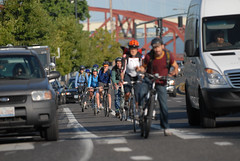
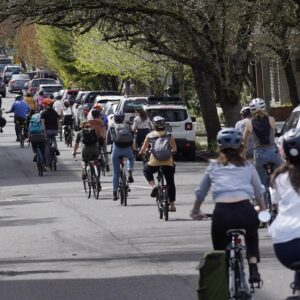
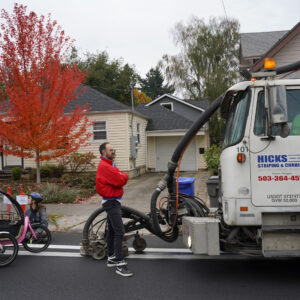
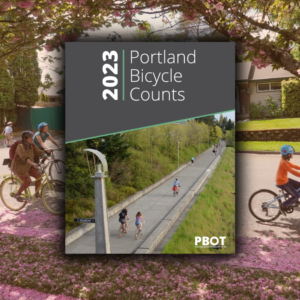
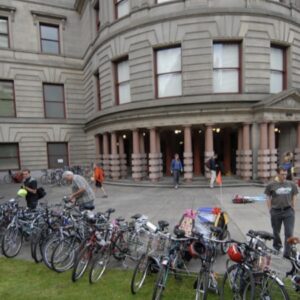
Thanks for reading.
BikePortland has served this community with independent community journalism since 2005. We rely on subscriptions from readers like you to survive. Your financial support is vital in keeping this valuable resource alive and well.
Please subscribe today to strengthen and expand our work.
Whats the margin of error? 5.81 and 5.96 might statistically be the exact same thing.
JJ, according to our PBOT Options’ census bureau whiz Dan Bower, when you take into account the margin of error, the difference is a wash.
Good point, JJ.
Here are the raw numbers from ACS 2009.
Mode Number MOE High Low
Total 289700 +/-5890 295590 283810
Bike 16125 +/-2472 18597 13653
You can query the data for yourself here: ACS at American Fact Finder.
Stretching the margin of error to the max in either direction on the total number of commuters, and the number of bicycle commuters, we get this range:
Universe + MOE, Bike – MOE 4.62%
Universe – MOE, Bike + MOE 6.55%
jobs are down, many are not going to work by car or other transportation period. After losing my job I’ve been working from home, there for am not being counted in the commuting stat any longer. I still ride, just not to work.
Jonathan, I’d suggest you search your own site, collect all the posts with quotes of “statistics” of ridership, and compare them.
Now *that* would be an interesting blog post.
For example, your blog says:
“The most recent data collected by the U.S. Census’s American Community Survey (ACS) shows that the number of Portlanders who commute to work by bicycle has dropped from 4.4% in 2006 to 4.2% in 2007.”
Then, your blog says:
“The annual survey found that Portland’s bike commute mode share has risen to 6.4%”
But then this post says in 2009, the figure’s 5.81%.
So:
2006: 4.4%
2007: 4.2%
2008: 6.4%
2009: 5.81%
And so on. The truth is, statistically speaking, the number reported by the census is *about the same it’s been for a decade*. You can critique the ACS, but you’re not going to squeeze out some hidden factor that double the number, or shows some hidden defect that masks a steady increase.
Yet–isn’t it strange that even local government repeatedly claims that bicycle ridership is dramatically (to use Adams’ term from a few months ago) increasing? What’s behind that, I wonder?
And another example of using superlatives to mask uncomfortable statistics, from Alta Planning’s website:
Yet those who live in Portland know that exponential growth in bicycle ridership
That’s right: exponential. Using numbers quoted on Jonathan’s blog here, “exponential” growth would mean that growth had at least *doubled*, tripled, quintupled or more in the past several years. That is, unless Alta meant an exponent of one.
ecohuman (#7 & #8) – first off, exponential growth means nothing of the sort. 5% is exponential growth, but a 5% annual growth would have a doubling period of 14 years. Also, exponential growth in cyclists likely will not result in an increase in percentage mode share, since the overall population of greater Portland is ALSO increasing exponentially, and possibly at a higher rate than the number of cyclists.
These census percentages are practically useless without the underlying data and methodology. “Used a bicycle as their primary means of transportation to work” – that number will vary extensively due to many factors. The unemployment rate in Portland is nearly double what it was during the last census, but the number of people and the number of jobs have both increased in the last 10 years. “Primary means” could be a car for someone who rides 2 days a week on the bike, but in PBOT’s bridge counts, they still count as 40% of a “rider” who commutes all 5 days per week. It’s all in how you spin the numbers.
BTW, Jonathan, the title should perhaps be “5.81% of Portlanders commute primarily by bike”, for the reasons given in my previous post. It’s pretty obvious to anyone who polls more than just the US Census dataset that more than 5.8% are commuting on any given day.
For comparison, what % of Portlanders commute by foot, by public transportation, by car, by other means?
Numero, thanks for asking. I’ve added those stats to the end of the story. cheers. –Jonathan
Interesting to see how the % changes from year to year. Most interesting was the big drop in motorists in 2008 (from 73.4% to 68.8%) when the prices of oil and gasoline were very high. In the longer term, those prices will rise again. When peak oil inevitably hits (more say sooner than later), there will be far fewer cars on the roads, which makes me wonder why they want to expand the Interstate Bridge.
‘exponential’ has a very specific mathematical definition and I believe that ecohuman is correct.
Matt, its semantics, I believe you’re incorrect. Exponentiation is based on multiples of positive or negative integers, not proportions of those integers. It requires at least a doubling or a halving of an original value. You can’t extrapolate that from the prevalences given in the data. Alta overstated for anyone looking into it that literally.
I would be curious what the stats would be for students – both elementary/HS and college. Between all the colleges in PDX (PSU, L&C, U of P, Reed, art schools, massage/acupuncture, etc), I bet a lot of those students bike as primary transport.
US drivers: 82%
Portland drivers: 70%
BURR – I’m sorry. Concerning the definition of exponential growth, matt picio is correct and ecohuman is wrong. This doesn’t invalidate all of the points ecohuman makes, but it does validate some of those matt picio makes.
Nope, sorry. See definition of exponential growth below:
http://en.wikipedia.org/wiki/Exponential_growth
I’d just like to point out that the percentage of people primarily commuting by bike in Eugene is 10.8%, and walking is 6.7%
You guys may have more, but our percentage kicks your ass. 🙂
http://scr.bi/aF6Ri5
BURR,
Re-read the wikipedia page. What you are talking about is a subset of exponential growth called “geometric progression.” Matt’s description of a model where a population increases by 5% each year is exponential growth. You are describing a special case of exponential growth.
Chris et al,
How unexpected to see this tangent develop.
Folks, “exponential growth” has a clear, unequivocal meaning in statistics and the sciences. Matt Picio doesn’t seem to understand that, but he did make my main point for me when he said:
“It’s all in how you spin the numbers.”
And that’s what bothers me. I see a spectrum with lazy language at one end and blatant dishonesty at the other, and I think it does a disservice to any cause, pro or “anti” bike.
From the larger perspective, I think the effete wonkery of statistics like this is entirely missing the point. They simply don’t matter; they’re not going to convince anybody to ride (or not ride), and despite what you hear from government, they’re not going to convince politicians, either.
Yeah, what Seager said, but with even more glee and in your faceness =)
WeBikeEugene!
ecohuman —
re: exponential growth, see page 9 of the 2009 bike count report
http://www.portlandonline.com/transportation/index.cfm?c=44671&a=280429
1992 – 2008 bicycle traffic rates looks like an exponential growth curve to me.
What will the future bring — did the curve change shape pos-2008? Or is it just another blip in the growth curve like ’95, ’00 and ’04? Time will tell.
I think bicycling rates of the future depend largely on how well our governments continue to improve bicycling conditions.
Ted Buehler
The trick to reading statistics is to remember that all that they tell you is exactly what they tell you. These numbers do not reflect growth OR decline or even stagnation because of the margin of error. I absolutely hate sensationalist headlines based on statistics because 90% of people will read the headline and take it as fact.
By the way, my “90%” is totally made up. It’s easy to sound like you know what you’re talking about by making up some numbers.
Hey mister Bike Science Columnist:
From all the the interprative arguments regaurding statistics it might be worthwhile to have an “Interpreting and Understanding Statistics for Dummies.”
Statistical analysis is strictly a mathmatical field but it is obvious here how it encroaches on our daily lives and could use some educated educated explanation.
Seeing as how much math, and by extension statistics, plays a role in any engineering degree I can’t think of a more authoritative speaker on the subject here.
Re: comment #13 from “ms”
According to a spring 2009 survey of PSU students, 11% reported biking to campus as their primary mode during the previous week. A similar survey of PSU employees in 2008 shows that 10% of our faculty & staff are biking to work. While I think it’s true that bicycling is a very smart choice for college students, I think it’s a stretch to say Portland’s college students are tipping the scales of the city’s overall bicycle mode share. In case you’re interested, here’s how the rest our student’s arrive to class:
25% drive alone
38% ride transit
14% walk
6% carpool
6% other (motorcycle, dropped off, skateboard)
Our most recent numbers show an enrollment of over 29,000 students for the 2010-2011 school year, with approx. 2000 of those students in university housing.
The trick to reading statistics is to remember that all that they tell you is exactly what they tell you.
You can come up with statistics to prove anything, Eileen, fourfteen percent of all people know that.
ACS only asks about work trips, so unless I’m missing something trips to school aren’t counted unless you work there.
Another thing to keep in mind about the ACS data is it’s emphasis on commute trips. The emphasis on trips to work within the transportation field is because of it’s impact on peak travel (so we can make our highways big enough!), and because it’s easier to collect the data. But the truth is, MORE trips are made for non-work purposes. It’s it possible that the bicycle mode share for these non-work trips is higher, leading to a greater overall mode share.
“There are three kinds of lies- lies, damned lies, and statistics.” -Mark Twain
I don’t really have a problem with any of these stats, I just love quoting Mark Twain.
BURR (#11), jeff (#12) No, I am correct. See the following:
http://en.wikipedia.org/wiki/Exponential_growth
http://www.youtube.com/watch?v=F-QA2rkpBSY
It does not require a doubling in a given timeframe, merely percentage growth that feeds into itself – it will result in a doubling over time, equal roughly to 70 divided by the percentage rate.
ecohuman (#19) – No, I understand it quite well. Watch the Youtube clip I referenced above. “Exponential” requires an eventual doubling, but not necessarily within the timeframe being measured. An annual growth rate of 5% would double in 14 years – so growth rates of less than 6% would not double within the period between 2 census gatherings, but would still be exponential growth.
I agree with your “laziness” criticism 100%, and that was a major point of my original post.
I have never been asked how I get to work in a census or by any other means. How is the data gathered and how many people are asked? And how are they asked? I recently converted to 99% bike.
Matt, I’m sorry you’ve wasted so much of your time on researching and posting about the meaning of “exponential”, especially since you’ve missed the larger point entirely. (Hint: the larger point wasn’t a precise definition of “exponential”.) I’ll leave you to your own personal definition of the concept.
the “larger point” may not have been a quibble about the definition of “exponential growth,” but the fact is that five point anything is an order of magnitude (oh, no, another mathematical term of quibble over) greater than the national figures, and 16k in 2008 is more than twice what it was six years earlier and four times what it was six years before that. a more meaningful question might be whether one should expect the trend to continue or flatten. but we might also want to consider that these numbers are based only on bridge crossings, and thus do not account for nine-tenths of (for example) my trips.
Hey ecohuman —
Did you read my post? I think Portland bridge traffic, 1992 – 2008 looks like an exponential growth curve. Kind of like the y=x^3 curve in the wikipedia def.
Ted Buehler
Whatever definition you use, I hope we all can agree that bicycle traffic in Portland has gone up a while lot in the last 20 years. And that we hope it will continue to increase.
Keep in mind, the squeaky wheel gets the grease. When’s the last time you’ve told your elected officials that its important to you that they increase funding to bicycle projects relative to the amount of commuters riding? (Or any other such metric you care to use?)
Ted Buehler
Fred, surveys are mailed out every few months. The method and sample size is sound.
ecohuman (#32) – No harm done, research is my passion. I didn’t miss the larger point, but I disagree with your conclusions. There are plenty of metrics that show serious growth in the number of cyclists, and the census bureau’s methodology is both flawed and does not properly capture an accurate picture. the employment changes of the past 48 months calls into question the value of any metric that measures the percentage of mode share based on primary means of traveling to a job. With 1 in 7 Oregonians below the poverty line, and nearly 1 in 5 without a job, the statistic is misleading at least. See the 2nd paragraph of my post #7.
Oh, and regarding the last paragraph of post #19, I largely agree at the federal level, but statistics do have some influence in state politics, and I would argue they’re very relevant in local politics, though perhaps not as relevant as the personal agenda of the politician in question.
It’s interesting to note that they ask about the travel mode you use for the greatest distance and not the most time. So if you walk 3 miles to catch a bus, which you ride for 5 miles, you’d put down “bus,” even though you spend much more time walking.
“The greatest shortcoming of the human race is our inability to understand the exponential function.”
Al Bartlett
This is one of my favorite quotes. For the record, exponential growth can be a constant % growth, there is no requirement that the exponent be a whole number. Having said that, Alta planning misused the term, which is commonly done by people attempting to portray growth as being larger than it truly is.
As a final aside, if you ever have a chance to see Barlett’s presentation on exponential growth I would recommend it. It’s positively mind-blowing (especially if you’re a stats geek like me).